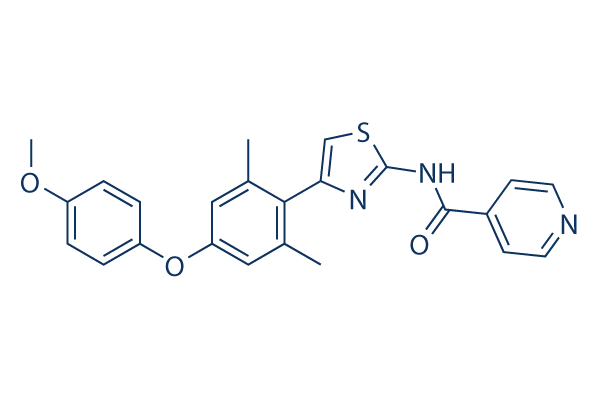TAI-1 (TAI 1; TAI1) is a selective Hec1 (High expression in cancer 1) inhibitor with potential anticancer activity. It inhibits the Hec1-Nek2 protein-protein interaction with a GI50 of 13.48 nM in K562 cells, which is >1000-fold higher than that of INH1 (GI50 =11.7 μM). TAI-1 showed strong anti-proliferative activity in vitro against a broad spectrum of cancer cells.
Physicochemical Properties
| Molecular Formula | C24H21N3O3S | |
| Molecular Weight | 431.51 | |
| Exact Mass | 431.13 | |
| CAS # | 1334921-03-7 | |
| Related CAS # |
|
|
| PubChem CID | 53389629 | |
| Appearance | White to off-white solid powder | |
| LogP | 5.948 | |
| Hydrogen Bond Donor Count | 1 | |
| Hydrogen Bond Acceptor Count | 6 | |
| Rotatable Bond Count | 6 | |
| Heavy Atom Count | 31 | |
| Complexity | 568 | |
| Defined Atom Stereocenter Count | 0 | |
| InChi Key | NBNNDUZYMXBCOX-UHFFFAOYSA-N | |
| InChi Code | InChI=1S/C24H21N3O3S/c1-15-12-20(30-19-6-4-18(29-3)5-7-19)13-16(2)22(15)21-14-31-24(26-21)27-23(28)17-8-10-25-11-9-17/h4-14H,1-3H3,(H,26,27,28) | |
| Chemical Name | N-[4-[4-(4-Methoxyphenoxy)-2,6-dimethylphenyl]-2-thiazolyl]-4-pyridinecarboxamide | |
| Synonyms |
|
|
| HS Tariff Code | 2934.99.9001 | |
| Storage |
Powder-20°C 3 years 4°C 2 years In solvent -80°C 6 months -20°C 1 month |
|
| Shipping Condition | Room temperature (This product is stable at ambient temperature for a few days during ordinary shipping and time spent in Customs) |
Biological Activity
| ln Vitro | TAI-1 causes apoptotic cell death, major chromosomal misalignment in metaphase, disruption of the Hec1-Nek2 protein connection, and Nek2 degradation[1]. According to evidence that TAI-1 triggers the activation of apoptotic pathways, it causes cancer cells to die by cleaving the apoptotic proteins Caspase 3 and PARP and degrading the anti-apoptotic protein MCL-1. With GI50 less than 100 nM, TAI-1 is effective against a wide range of cancer cells, including those with chronic myeloid leukemia, cervical cancer, breast cancer, metastatic-pleural, invasive ductal carcinoma, acute myeloid leukemia, myelogenous leukemia, and colorectal carcinoma cells[1]. |
| ln Vivo | In several cancer xenograft models, TAI-1 (20 mg/kg intravenously IV; 150 mg/kg oral PO/BID) suppresses tumor growth[1]. |
| Animal Protocol |
Animal/Disease Models: CB-17 SCID (severe combined immunodeficient) mouse (6-7 weeks, 21- 24 g)[1]. Doses: 20 mg/kg intravenously (iv)IV/ or 150 mg/kg per oral PO/BID. Route of Administration: QDx28 cycles. Experimental Results: Led to significant tumor growth retardation in Huh-7 and modest tumor inhibition was noted tor the Colo205 and MDA-MB-231 models. Did not lead to any loss in body weight. |
| References |
[1]. Characterization of the Biological Activity of a Potent Small Molecule Hec1 Inhibitor TAI-1. J Exp Clin Cancer Res. 2014 Jan 9;33(1):6. |
Solubility Data
| Solubility (In Vitro) |
|
|||
| Solubility (In Vivo) |
Solubility in Formulation 1: ≥ 2.5 mg/mL (5.79 mM) (saturation unknown) in 10% DMSO + 90% Corn Oil (add these co-solvents sequentially from left to right, and one by one), clear solution. For example, if 1 mL of working solution is to be prepared, you can add 100 μL of 25.0 mg/mL clear DMSO stock solution to 900 μL of corn oil and mix evenly. (Please use freshly prepared in vivo formulations for optimal results.) |
| Preparing Stock Solutions | 1 mg | 5 mg | 10 mg | |
| 1 mM | 2.3174 mL | 11.5872 mL | 23.1744 mL | |
| 5 mM | 0.4635 mL | 2.3174 mL | 4.6349 mL | |
| 10 mM | 0.2317 mL | 1.1587 mL | 2.3174 mL |
